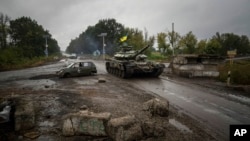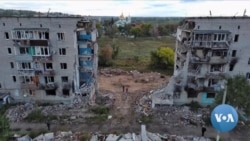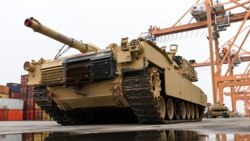Ukraine’s government said Tuesday that a human rights report detailing “numerous cases” in which Ukrainian forces deployed banned anti-personnel mines “will be duly studied by the competent authorities of Ukraine.”
Ukraine “fully implements its international obligations while Russian occupants commit the war crimes, crimes against humanity and genocide of the Ukrainian people,” the Ministry of Foreign Affairs said in response to a Human Rights Watch report that provides multiple detailed accounts that Ukraine’s military launched the weapons against Russian military positions in the fierce battle for the eastern city of Izium last year.
The report raises questions about Kyiv’s credibility and intentions as NATO allies pour billions of dollars’ worth of aid and weapons into Ukraine as the Russian invasion nears the one-year mark.
“They may get some very difficult questions from the people who've been supplying them with other types of weapons about their ability to use them in a way consistent with international humanitarian law,” Steve Goose, director of the arms division at Human Rights Watch, told VOA ahead of the report’s release. That office of the rights watchdog promotes humanitarian disarmament. The rights group is calling for an investigation in Ukraine
VOA asked the White House for its response to the report, specifically, whether such allegations would affect the Washington-Kyiv relationship and whether the U.S. will support an investigation.
“We welcome the Government of Ukraine’s announcement it will investigate these allegations, and we appreciate Ukraine reaffirming its commitment to respect its obligations and commitments under international law,” an NSC spokesperson said. The official declined to be named, as is common practice when the White House briefs reporters.
“Human Rights Watch also reported that Russia has engaged in irresponsible, systematic, and widespread use of explosives, including anti-personnel landmines, which have caused extensive damage to civilian infrastructure and injured and killed thousands of Ukraine’s civilians,” the official added.
George Beebe, director of grand strategy at the Quincy Institute for Responsible Statecraft, told VOA that the allegations are unlikely to hurt the strong relationship between Kyiv, Washington and NATO. But he said they complicate the West’s straightforward narrative of the conflict in the formerly colonized parts of the world that are often collectively known as the Global South.
“I doubt that this will have much of an impact on the West’s belief that it needs to continue to support Ukraine against Russia in this war,” he said. “Where it might have more of an impact is in other parts of the world — in the Global South, which is, I think, much less prone to seeing this war as a fight between good and evil, and much more a war that involves shades of gray, in which both sides have done things that the Global South regards as questionable. And I think this is likely to reinforce that perception in the Global South that Ukraine is not an unalloyed white knight in this battle.”
Between April and September, residents told researchers, rockets launched from Ukrainian-held territory scattered thousands of Soviet-era PFM-1 “butterfly mines” over Russian military facilities in Izium, which Russian forces entered in April. The Ukrainian counteroffensive started in September, and their swift victory over the strategically important railway hub was seen by some military analysts as a turning point in the conflict.
Researchers in Izium, a city in Ukraine’s Donbas region, spoke to health care workers and counted 11 civilian deaths caused by mines, and 50 wounded civilians. Half of those cases involved amputations of the foot or lower leg — a common injury caused by anti-personnel mines. At least five of the wounded were children.
Russia’s Foreign Ministry had previously accused Ukraine of using the Soviet-designed mines, which were banned in 1997 under the Mine Ban Treaty, also known as the Ottawa Treaty, signed in Canada’s capital. Ukraine has also accused Russia of using banned munitions.
On numerous occasions, Human Rights Watch has accused Russia of using other types of anti-personnel mines in Ukraine and of committing a number of atrocities, including kidnapping and torture, during their occupation of Izium.
The International Campaign to Ban Landmines told VOA that the next steps are clear, as are the implications.
“States Parties to the (Mine Ban) treaty should urge Ukraine authorities to immediately conduct an investigation to determine who deliberately used or ordered the use of these weapons as they may be criminally liable,” representatives of the global advocacy group told VOA in a written statement on behalf of the group. “Landmines are indiscriminate weapons which cannot differentiate between civilians and military, their use may constitute a war crime.”
Ukraine inherited more than 6 million of these mines after the dissolution of the Soviet Union in 1991. In 2021, Ukraine reported to the United Nations that it had 3.3 million mines still in stock, awaiting destruction.
The bright green plastic weapons have two “wings” that stretch out over 11.9 centimeters — or about the width of a child’s cupped hands. They weigh, on average, 75 grams — the same as a medium apple, banana or pear. By design, the mines cannot be disarmed; they must be detonated or destroyed.
Those alluring attributes, Goose told VOA, disguise the mines’ danger.
“They [mines] can't tell the difference between a soldier and a civilian,” he said. “They go on killing and injuring people long after wars are over. They require a huge effort to try to get rid of them, to demine them and to help the victims. They're despicable weapons that have done nothing but cause harm, and those victims are almost always civilians rather than military personnel.”
After being notified by Human Rights Watch in November, Ukraine Deputy Defense Minister Oleksandr Polishchuk did not directly respond to questions about whether his forces used the banned mines but wrote to the rights group, “Ukraine is a reliable member of the international community, and it fully commits to all international obligations in the sphere of mine usage. This includes the non-use of anti-personnel mines in the war.”
The U.S. has previously had a conversation about the responsible use of weapons in Ukraine. In the early months of the conflict, Washington obliged Kyiv’s request for an undisclosed number of Claymore munitions, which are American-designed plastic anti-personnel mines.
“The way they’re constructed is they [Claymore munitions] have to be manually triggered by an operator, so they are not subject to the Ottawa Convention,” National Security Council spokesman John Kirby told VOA in June, referring to the Mine Ban Treaty.
But when fitted with a tripwire firing system, the Vietnam War-era weapons can be victim-activated, which is a violation of the Ottawa Treaty.
A senior administration official also told VOA in April that the issue was specifically discussed.
“We asked the Ukrainians, and they assured us they would remain command-operated in order for us to agree to do that and to ensure it is compliant with the Ottawa Treaty, which Ukraine has been compliant with,” said the official, who asked not to be named, as is common when briefing reporters on background.
“These are Ukrainians who are defending their own country and their own territory,” the official added.
These concerns come amid the backdrop of what appears to be a renewed Ukrainian push, as the war appears poised to enter its second year. Earlier in January, the U.S. obliged Ukraine’s request for armored vehicles, agreeing to send 31 M1 Abrams tanks.
Kyiv is now calling for American-made F-16 fighter jets.
On Monday, VOA asked President Joe Biden if the U.S. would send the planes.
“No,” he said.
Iuliia Iarmolenko contributed to this report.















